Archaeohippus blackbergi
Quick Facts
Common Name: Blackberg’s dwarf horse
Archaeohippus is a genus of three-toed horses that lived 19 to 13 million years ago in North America. Two of the five known species lived in Florida.
Archaeohippus blackbergi was small, weighing approximately between 50 and 66 pounds.
A mounted skeleton of Archaeohippus blackbergi is on permanent public display in the Hall of Florida Fossils at the Florida Museum of Natural History. It is a composite, made up of hundreds of isolated bones from Thomas Farm, matched with those of similar size. It is the only mounted skeleton on display in the world for the genus Archaeohippus.
Age Range
- Late early Miocene Epoch; Hemingfordian 1 and 2 land mammal ages
- About 19 to 16 million years ago
Scientific Name and Classification
Archaeohippus blackbergi Hay, 1924
Source of Species Name: Named for Dr. Solon N. Blackberg, a professor of veterinary medicine at Texas A&M University. According to Hay (1924), Blackberg was “an enthusiastic assistant” to Dr. Mark Francis, also a professor at Texas A&M, during the collection of vertebrate fossils later studied by Hay.
Classification: Mammalia, Eutheria, Laurasiatheria, Perissodactyla, Hippomorpha, Equidae, Equinae
Alternate Scientific Name: Miohippus blackbergi, Parahippus blackbergi, Parahippus minutalis, Archaeohippus nanus
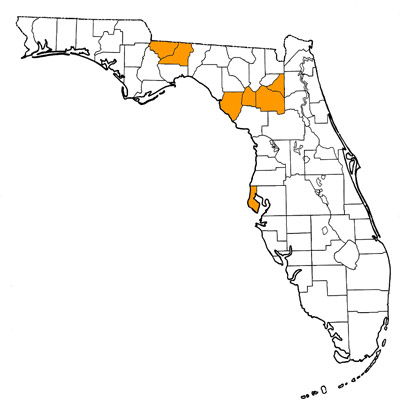
Overall Geographic Range
Known definitively from only the Texas Gulf Coastal Plain (Garvin Gully Fauna sites) and Florida. Possible but not definitely identified records derive from Delaware (Emry and Eshelman, 1998) and South Dakota. Type locality is Jesse Garvin Farm, 2.3 miles north of Navasota, Grimes County, Texas (Hay, 1924).
Florida Fossil Occurrences
Florida fossil sites with Archaeohippus blackbergi:
- Alachua County—Colclough Hill; Lower Gainesville Creeks Fauna
- Bradford County—Brooks Sink
- Dixie County—Miller Site
- Gadsden County—Dover Mine; Fullers Earth Company Midway Mine; Fullers Earth Company Quincy Mine
- Gilchrist County—Thomas Farm
- Leon County—Seaboard Airline Rail Road Site
- Pinellas County—Oldsmar; Rabbit Island
Discussion
Archaeohippus is a genus of small-sized horses that lived during the late Oligocene through middle Miocene of North America. A total of five species are currently recognized for this genus (O’Sullivan, 2003), of which just two are known from Florida, Archaeohippus blackbergi and Archaeohippus mannulus. In addition to small size [estimated body masses range from about 10 to 30 kg (22-66 pounds)], members of this genus are characterized by relatively simple, low-crowned (brachyodont) teeth (Fig. 2) and long, slender metapodials and phalanges (Fig. 3). The former is a primitive condition shared with species of Miohippus, Anchitherium, and Hypohippus, while the latter is a derived feature shared with Parahippus, Merychippus, and other members of the Equinae. This combination of primitive teeth and specialized feet long caused disagreement on how to classify the species of Archaeohippus. The taxonomic history of Archaeohippus blackbergi is emblematic of this problem.
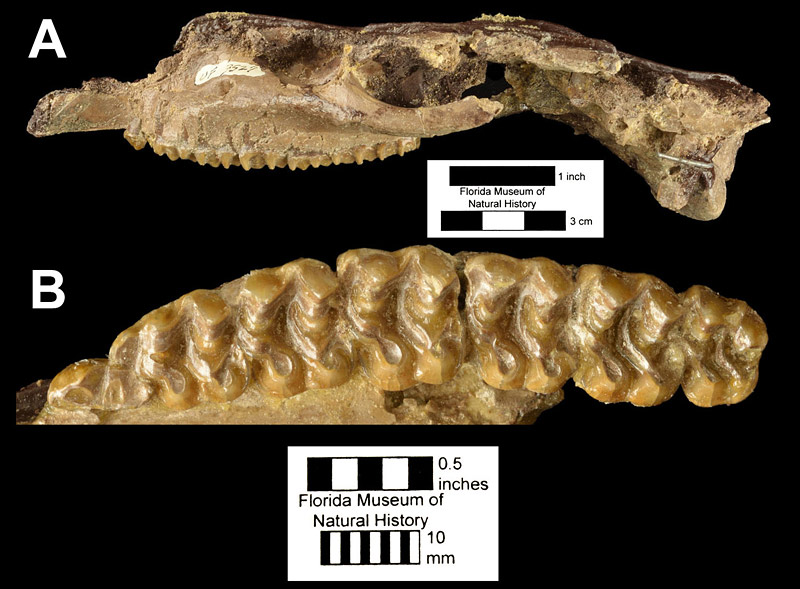
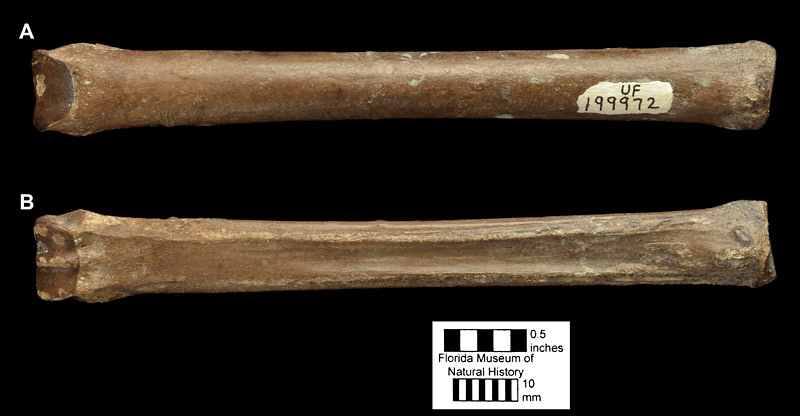
In his initial description, Hay (1924) actually proposed two species names for small horses from the same fossil site in Texas, Miohippus blackbergi and Parahippus minutalis. The few upper teeth on which he based Miohippus blackbergi lacked a small fold in the enamel called a crochet, while those he called Parahippus minutalis had a crochet. When larger samples of teeth became available for study, it became evident to most paleontologists studying these horses that this feature varied intraspecifically in its presence/absence and relative size (e.g., Bader, 1956; Forsten, 1975). Thus it has long been agreed that Miohippus blackbergi and Parahippus minutalis represent the same species, and because it was named first in Hay’s (1924) study, Miohippus blackbergi is regarded as the valid species name (the “senior synonym”).
The first report of the species in Florida occurred in the earliest account of fossils from the Thomas Farm site by G. G. Simpson (1932). Simpson (1932) either did not know of the publication of Hay (1924), or chose to ignore it, as he made no comparisons between those species of mammals he named from Thomas Farm and those Hay had named from Garvin Farm eight years earlier. Simpson (1932) proposed the name Archaeohippus nanus for the smallest Thomas Farm horse. Starting with White (1942), most paleontologists working on these equids have considered Simpson’s species a junior synonym of Hay’s species (e.g., Bader, 1956; Forsten, 1975; O’Sullivan, 2003).
For about 50 years, the generic allocation of Hay’s species Miohippus blackbergi was greatly debated. One group of paleontologists favored placing the species in Parahippus, primarily because some characters of its teeth more resembled species in the genus Parahippus rather than the teeth found in Archaeohippus ultimus, the type species of the genus Archaeohippus. Studies favoring this hypothesis include Schlaikjer (1937), White (1942), Bader (1956), Olsen (1964), and Sondaar (1969). A second group favored placing Hay’s species in the genus Archaeohippus, based on a different combination of characters of the teeth, and once they became known, of the skull. Works supporting this view include Stirton (1940), Quinn (1955), Downs (1956), and Forsten (1975). Up until the publication of Forsten (1975), the species was more often referred to Parahippus than Archaeohippus, but following publication of her work the species has consistently been placed in Archaeohippus. O’Sullivan (2008) published the results of a phylogenetic analysis which showed Archaeohippus blackbergi more closely related to Archaeohippus ultimus and Archaeohippus mourningi than it is to species of Parahippus; however the details of this analysis remain unpublished (they are in his 2002 dissertation).
Although originally named from Texas, and known from at least nine localities in Florida, by far the most specimens of Archaeohippus blackbergi derive from just one site, Thomas Farm. The Florida Museum of Natural History houses over 10,000 specimens ofArchaeohippus blackbergi from Thomas Farm, and the Museum of Comparative Zoology at Harvard University has a smaller but substantial collection. Thus most of our knowledge about the anatomy and ecology of this species comes from this prolific site. Archaeohippus blackbergi is the second most common medium- to large-sized mammal at Thomas Farm, outnumbered by Parahippus leonensis by a factor of about 2:1 (Pratt, 1990). The Thomas Farm samples of both of these species are among the largest known single-site accumulations of horses in the fossil record.
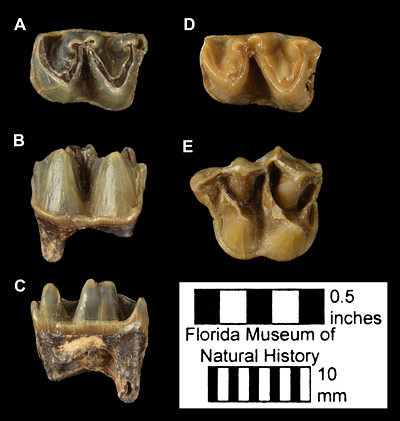
The crowns of the teeth of Archaeohippus blackbergi are short, almost always lack any trace of cement, and consist of relatively simple ridges in contrast to the more complex patterns found in Parahippus leonensis and younger members of the Equinae (Fig. 4). Presence/absence and development of a crochet and a lingual cingulum show a high degree of variation on the six major upper cheek teeth (P2-M3); the same is true for the labial (lateral) cingulid on the corresponding lower teeth (present in Fig. 4B). The third upper molar is distinctly smaller than the second upper molar (Fig. 2B); likewise the lower third molar is not tremendously elongated posteriorly as is characteristic of advanced equine horses. Horses like Archaeohippus with short tooth crowns have historically been thought to have had a diet primarily or exclusively of relatively soft leaves and other browse, and only small amounts (if any) of abrasive grasses. This has recently been confirmed for the Thomas Farm sample of Archaeohippus blackbergi by analysis of the relative amounts and shapes of microscopic-sized pits and scratches on tooth enamel (Semprebon et al., 2012). Supporting this is the manner in which the molar teeth wear, a technique called mesowear analysis (Mihlbachler et al., 2011). Modern mammals with diets primarily of highly abrasive vegetation such as grasses quickly wear the cusps of their teeth relatively flat. Species eating softer leaves from bushes and shrubs retain taller, more sharply pointed tooth cusps. The paracone and metacone on the molars of Archaeohippus blackbergi remain sharp and project far beyond the mesostyle even after considerable wear.
O’Sullivan (2005) analyzed the Thomas Farm sample of Archaeohippus blackbergi to learn about aspects of its life history. He found that individual potential longevity was about seven years, although few survived longer than five years. He also found a relatively high level of mortality in young adults, which he attributed to fatalities in combat between older, more experienced males and younger, less experienced males for control of herds and access to females. While such battles are common in modern Equus and have likely occurred in most species of horses going back many millions of years, O’Sullivan (2005) noted that combat in Archaeohippus blackbergi was potentially more dangerous due to relatively larger and sharper canine teeth in males of this species (Figure 5).
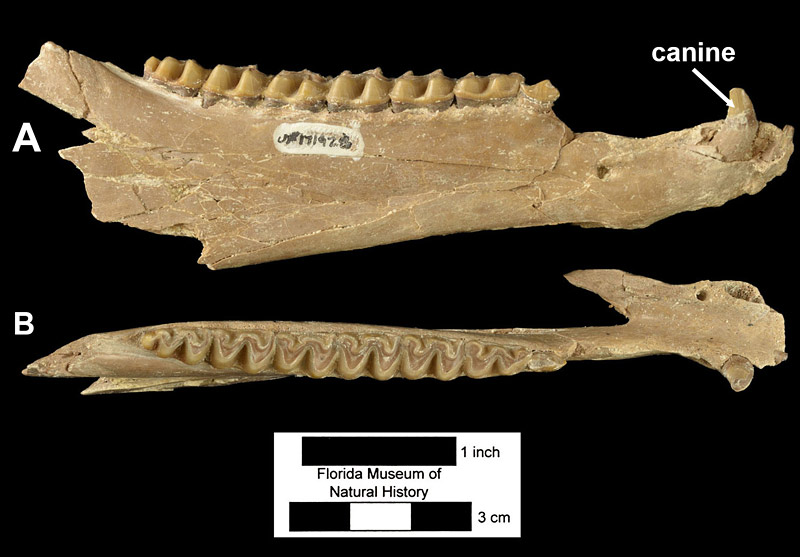
A mounted skeleton of Archaeohippus blackbergi is on permanent public display in the Hall of Florida Fossils at the Florida Museum of Natural History. It is a composite, made up of hundreds of isolated bones from Thomas Farm, matched with those of similar size. It is the only mounted skeleton on display in the world for the genus Archaeohippus.
Sources
- Original Author(s): Richard C. Hulbert Jr.
- Original Completion Date: September 22, 2012
- Editor(s) Name(s): Richard C. Hulbert Jr. and Natali Valdes
- Last Updated On: February 25, 2015
This material is based upon work supported by the National Science Foundation under Grant Number CSBR 1203222, Jonathan Bloch, Principal Investigator. Any opinions, findings, and conclusions or recommendations expressed in this material are those of the author(s) and do not necessarily reflect the views of the National Science Foundation.
Copyright © Florida Museum of Natural History, University of Florida